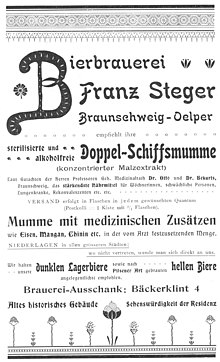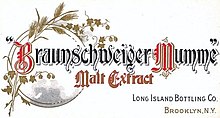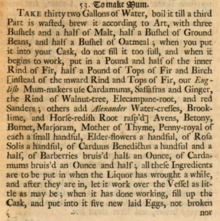Brunswick Mum (German: Braunschweiger Mumme, Latin: Mumma Brunsvicensium or Mumia, French: Mom de Bronsvic), was originally an alcoholic beer from Brunswick in Germany, which ranged from weak to strong depending on the brewing method.[1] One of the first black beers recorded in history.



History
editMum originated in the Late Middle Ages.[2] The composition gave the beer a long shelf life that allowed a wide distribution; mum became the most important export from Brunswick and, in the early modern period was shipped to places such as India and the Caribbean. The drink is still sold in Brunswick where since autumn 2008, for the first time in about 200 years, it is produced in alcoholic variants.[3]
Composition
editThe 17th-century author David Kellner describes mum as being held in high esteem for its exquisite strength, lovely taste and beautiful brown color.[4] The three types of mum (Schiff-Mumme, Stadt-Mumme, Erndte-Bier) mentioned by Kellner are solely composed of barley-malt and hops.
In contrast to German sources is mum in English literature from the early modern period an unhopped strong wheat-beer, made with the addition of various aromatic herbs.[5] The oldest English recipe seems to be published 1682 in The Natural History of Coffee, Thee, Chocolate, Tobacco by John Chamberlayne and is said to be recorded in Brunswick.[6]
The recipe calls for seven bushels of wheat-malt, one bushel of oat-malt and one bushel of ground beans to make 63 gallons of mum. Eggs are added to prevent the beer from becoming sour. Variations of this recipe are published by later authors, for instance John Nott.[7][a]
Elisha Coles in An English Dictionary (1677) states that mum is "a kind of Physical Beer made (originally) at Brunswick in Germany, with husks of walnuts infused".[9]
Notes
editReferences
edit- ^ "Die Braunschweiger Mumme". Archived from the original on 2009-12-17. Retrieved 2024-04-22.
- ^ "Mugwort - Muscovy yarn". British History. Retrieved 2010-03-24.
- ^ Braunschweiger Mumme-Meile
- ^ Kellner, David (1690). Hochnutzbar und bewährte Edle Bierbrau-Kunst (in German). Leipzig / Gotha: Augustus Boëtius. p. 138.
- ^ Bickerdyke, John (1965). The Curiosities of Ale and Beer. London: Spring Books. pp. 172–173.
- ^ Chamberlayne, John (1682). The Natural History of Coffee, Thee, Chocolate, Tobacco. London: C. Wilkinson. pp. 32–33.
- ^ Nott, John (1723). The Cooks and Confectioners Dictionary. London: C. Rivington.
- ^ Maynwaringe, Everard (1683). The Method and Means of enjoying Health, Vigour, and long Life. London: Dorman Newman. p. 119.
- ^ Coles, Elisha (1677). An English Dictionary explaining the difficult Terms that are used in Divinity, Husbandry, Physick, Phylosophy, Law, Navigation, Mathematicks, and other Arts and Sciences. London: Printed for Peter Parker.
Further reading
edit- Christian Basilius: Die Mumme-Fibel der Mumme H. Nettelbeck K.G. Geschichte(n) seit 1390. Braunschweig 1999.
- Gerd Biegel (December 2009), Braunschweig Stadtmarketing; H. Nettelbeck (eds.), Das Braunschweiger Mumme-Buch. Geschichte und Rezepte, Braunschweig, ISBN 978-3-00-029718-2
{{citation}}: CS1 maint: location missing publisher (link) - Andreas Döring: Wirth! Nochmal zwo Viertel Stübchen! Braunschweiger Gaststätten & Braunschweiger Bier damals. Braunschweig 1997.
- Anna Klie: Brunswyksche Mumme. Braunschweig 1898.
- Heinrich Mack: Zur Geschichte der Mumme. Insbesondere des Mummehandels im 17. Jahrhundert. in: Braunschweigisches Magazin. Zwißler, Wolfenbüttel 1911,17.
- Ernst A. Roloff: Heimatchronik der Stadt Braunschweig. Archiv für Deutsche Heimatpflege, Köln 1955.
- Gerd Spies: Das Mummetor. Miszellen. Bd 25. Städtisches Museum Braunschweig, Braunschweig 1976. ISSN 0934-6201
External links
edit- Official website of Nettelbeck KG, the last mum-brewery
- Chambers, E. (1741). Mum. In Cyclopaedia (4th ed.)
- Krünitz, G. K. (1773). Braunschweiger Mumme. In Oeconomische Encyclopädie
- Julius Stinde: Zwei Veteranen des Bierstaates (1880) about mum and gose
- About mum in The Curiosities of Ale and Beer (originally published 1889) by John Bickerdyke